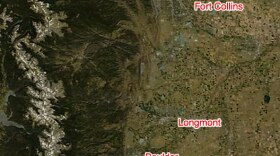The Fort Collins-Loveland Airport is playing a key role in the efforts to fight the High Park Fire. The small commuter airport located between the two cities is a landing and refueling place for single engine air tankers and helicopters. Rocky Mountain Metropolitan Airport in Jefferson County is the base for heavy air tankers.
Before air operations got underway this morning, airport director Jason Licon took KUNC on a tour of bustling tarmac.
“The coolest thing is how everyone is working together to achieve a common goal,” says Licon as he drives slowly. “There are a lot of different organizations—whether they’re government groups or private contractors—and they’re all working together to get this fire put out.”
The first stop is a giant orange helicopter, a so-called sky crane or snorkel helicopter. It has a hose that sucks up to 2,600 gallons of water to drop over hot spots. The engine just below the blades looks as big as a single-car garage.
“This air crane is one of the most complex pieces of machinery,” says Licon. “It requires a lot more maintenance and overall upkeep to maintain it flying.”
The helicopters can stay in the air for about two-and-a-half hours, but come back to the airport for refueling.
Parked off to one side of the central landing strip are single engine air tankers, or SEAT, planes.
The small, white aircraft have red markings and are parked next to large tanks of fire retardant.
“A lot people ask what these crazy markings are on the SEAT ramp,” says Licon pointing to unique yellow paint markings on the ground. “They look almost like volleyballs. They’re designed so two aircraft can pull up and load the chemicals, and the pilots are able to visually see where they need to be.”
As Licon drives toward three Blackhawk helicopters at the opposite end of the tarmac, he passes small recreational planes that have been tied down on the ramp. Licon says staff have been busy moving the aircraft as more planes are brought in to fight the fire.
“We’ve been shuffling them around constantly to make sure we have room for everyone,” he says.
The army green Blackhawks are the latest addition to this busy tarmac. They were flown in from the Wyoming, Nebraska and Kansas National Guard.
This airport is about to become a lot busier tomorrow as officials increase aircraft from 26 to 100.










